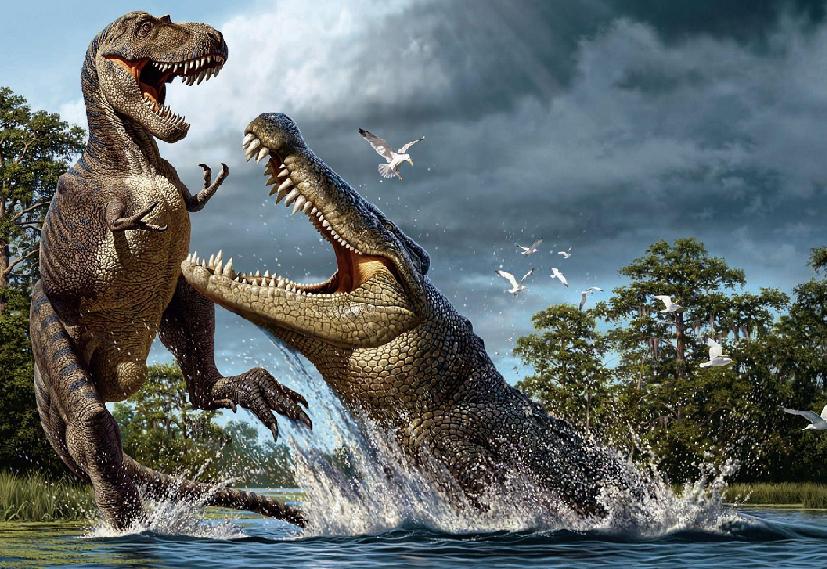Post by dinosauria101 on Mar 12, 2019 1:53:58 GMT 5
Deinosuchus rugosus
Deinosuchus is an extinct genus related to the alligator that lived 73 to 80 Ma (million years ago), during the late Cretaceous period. The name translates as "terrible crocodile" and is derived from the Greek deinos (δεινός), "terrible", and soukhos (σοῦχος), "crocodile". The first remains were discovered in North Carolina (United States) in the 1850s; the genus was named and described in 1909. Additional fragments were discovered in the 1940s and were later incorporated into an influential, though inaccurate, skull reconstruction at the American Museum of Natural History. Knowledge of Deinosuchus remains incomplete, but better cranial material found in recent years has expanded scientific understanding of this massive predator. Although Deinosuchus was far larger than any modern crocodile or alligator—measuring up to 12 m (39 ft) and weighing up to 8.5 metric tons (9.4 short tons)—in overall appearance it was fairly similar to its smaller relatives. It had large, robust teeth that were built for crushing, and its back was covered with thick hemispherical osteoderms. One study indicates that Deinosuchus may have lived for up to 50 years, growing at a rate similar to that of modern crocodilians, but maintaining this growth over a much longer period of time. Deinosuchus was probably capable of killing and eating large dinosaurs. It may have also fed upon sea turtles, fish, and other aquatic and terrestrial prey.

Dakotaraptor steini (pack of 12)
Dakotaraptor is a genus of large carnivorous dromaeosaurid theropod from the Late Cretaceous of North America. The first fossils of Dakotaraptor were found in South Dakota, United States, in 2005. In 2015, the genus Dakotaraptor received its name, meaning "plunderer of Dakota", when the type species Dakotaraptor steini was described. The fossils contain an incomplete skeleton without a skull and some individual bones. They have been found in the Maastrichtian-age Hell Creek Formation, dated to the very end of the Cretaceous period, making Dakotaraptor one of the last surviving dromaeosaurids. It had long arms with one of the lower arm bones showing quill knobs, demonstrating that it was most likely feathered. It also had long rear legs with a very large sickle claw on the second toe; this claw could be used to kill relatively large plant-eating dinosaurs. It lived in the same time and area as many iconic late Cretaceous dinosaurs such as Ankylosaurus, Triceratops, and Tyrannosaurus. Dakotaraptor is exceptionally large for a dromaeosaurid; it has an estimated adult length of 5.5 m (18 ft) and a weight of 250-450 kilograms (550-1000 pounds).This approaches the size of the largest known dromaeosaurid, Utahraptor. Dakotaraptor however, does not have the proportions and adaptations of Utahraptor, but more closely resembles smaller dromaeosaurids like Deinonychus.

Credit to Wikipedia
Deinosuchus is an extinct genus related to the alligator that lived 73 to 80 Ma (million years ago), during the late Cretaceous period. The name translates as "terrible crocodile" and is derived from the Greek deinos (δεινός), "terrible", and soukhos (σοῦχος), "crocodile". The first remains were discovered in North Carolina (United States) in the 1850s; the genus was named and described in 1909. Additional fragments were discovered in the 1940s and were later incorporated into an influential, though inaccurate, skull reconstruction at the American Museum of Natural History. Knowledge of Deinosuchus remains incomplete, but better cranial material found in recent years has expanded scientific understanding of this massive predator. Although Deinosuchus was far larger than any modern crocodile or alligator—measuring up to 12 m (39 ft) and weighing up to 8.5 metric tons (9.4 short tons)—in overall appearance it was fairly similar to its smaller relatives. It had large, robust teeth that were built for crushing, and its back was covered with thick hemispherical osteoderms. One study indicates that Deinosuchus may have lived for up to 50 years, growing at a rate similar to that of modern crocodilians, but maintaining this growth over a much longer period of time. Deinosuchus was probably capable of killing and eating large dinosaurs. It may have also fed upon sea turtles, fish, and other aquatic and terrestrial prey.
Dakotaraptor steini (pack of 12)
Dakotaraptor is a genus of large carnivorous dromaeosaurid theropod from the Late Cretaceous of North America. The first fossils of Dakotaraptor were found in South Dakota, United States, in 2005. In 2015, the genus Dakotaraptor received its name, meaning "plunderer of Dakota", when the type species Dakotaraptor steini was described. The fossils contain an incomplete skeleton without a skull and some individual bones. They have been found in the Maastrichtian-age Hell Creek Formation, dated to the very end of the Cretaceous period, making Dakotaraptor one of the last surviving dromaeosaurids. It had long arms with one of the lower arm bones showing quill knobs, demonstrating that it was most likely feathered. It also had long rear legs with a very large sickle claw on the second toe; this claw could be used to kill relatively large plant-eating dinosaurs. It lived in the same time and area as many iconic late Cretaceous dinosaurs such as Ankylosaurus, Triceratops, and Tyrannosaurus. Dakotaraptor is exceptionally large for a dromaeosaurid; it has an estimated adult length of 5.5 m (18 ft) and a weight of 250-450 kilograms (550-1000 pounds).This approaches the size of the largest known dromaeosaurid, Utahraptor. Dakotaraptor however, does not have the proportions and adaptations of Utahraptor, but more closely resembles smaller dromaeosaurids like Deinonychus.

Credit to Wikipedia


